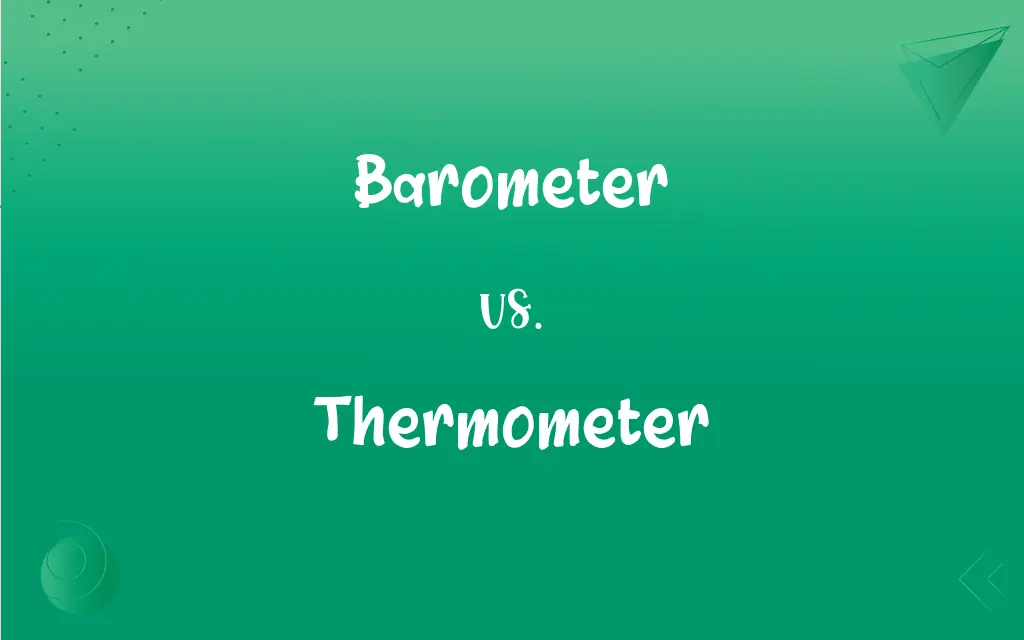Barometer vs. Thermometer: What's the Difference?
Edited by Janet White || By Harlon Moss || Updated on October 10, 2023
A barometer measures atmospheric pressure, while a thermometer measures temperature.

Key Differences
A barometer and a thermometer serve as vital instruments in meteorology and various scientific applications, yet they measure different physical properties related to atmospheric conditions. The barometer is primarily designed to measure atmospheric pressure, providing vital data that aids meteorologists in predicting short-term weather changes by indicating whether the atmospheric pressure is rising or falling. In contrast, a thermometer is an instrument used to measure temperature, providing information about the degree of heat or cold in a particular environment, and it can be utilized in diverse contexts, from weather stations to medical applications, reflecting the fundamental differences in their functional scopes and applications.
Although barometers and thermometers are utilized in related domains, particularly in weather forecasting, their mechanisms of action and the physical principles upon which they operate are distinctly different. A barometer typically operates by balancing the weight of mercury in the glass tube against the atmospheric pressure, with the height of the mercury column reflecting the external pressure. On the other hand, a thermometer often utilizes the predictable expansion and contraction of a fluid, frequently mercury or alcohol, or utilizes electronic means to gauge temperature, illustrating their divergent operational principles, even within related utilitarian contexts.
While both barometers and thermometers can be found in various designs and models, their aesthetic and structural characteristics are often tailored to their specific measurement functionalities. Barometers, particularly traditional mercury barometers, typically feature a long, enclosed tube containing mercury, with an open or vacuumed end exposed to the external pressure, and may exhibit a visually imposing and vertically elongated structure. Conversely, thermometers may adopt a variety of forms, from the classic mercury-in-glass design to modern digital displays, providing temperature readings through varied means, reflecting their respective operational needs and technological adaptations.
Barometers and thermometers each provide crucial data that can be applied to anticipate and understand various environmental and physical phenomena, yet the nature and implications of the data they provide are inherently distinct. The data from a barometer, which reveals the pressure exerted by the atmosphere, can be critical for predicting weather changes, with falling pressure often indicating impending storms and rising pressure suggesting clearer skies. Thermometers, by providing data on temperature, inform about the kinetic energy of particles in a substance or space and have broad applications, from helping to predict weather patterns to monitoring health through body temperature, illustrating their distinctive contributions to our interpretation and navigation of the physical world.
In practical and everyday contexts, both barometers and thermometers have been essential tools, enhancing our ability to interact with and respond to our environments by providing vital physical data. Barometers, through their capacity to gauge atmospheric pressure, have traditionally been used by mariners and meteorologists to anticipate weather changes, serving as a crucial tool in navigation and planning. Thermometers, with their ability to measure temperature, find utility in various daily applications, from cooking to regulating indoor climates, and have been fundamental in medical contexts for monitoring body temperature, showcasing the pervasive and fundamental roles they play across varied aspects of human activity and industry.
ADVERTISEMENT
Comparison Chart
Measures
Atmospheric pressure
Temperature
Principle
Vacuumed column of mercury or aneroid chamber
Mercury, alcohol, or electronic means
Predictive Use
Predict weather changes based on pressure fluctuations
Directly indicates current hot or cold conditions
Common Types
Mercury barometer, aneroid barometer
Mercury thermometer, digital thermometer
Associated Field
Meteorology
Meteorology, health, cooking, and scientific research
ADVERTISEMENT
Barometer and Thermometer Definitions
Barometer
A device that uses mercury or aneroid mechanisms.
This antique barometer relies on a mercury column to show atmospheric pressure.
Thermometer
An instrument measuring temperature.
She used a thermometer to check if she had a fever.
Barometer
An indicator of changes or trends in a particular area.
His mood serves as a barometer for the office environment.
Thermometer
A device indicating hotness or coldness.
The thermometer outside read 100°F, signaling a hot day.
Barometer
An instrument measuring atmospheric pressure.
The barometer indicated a sharp drop in pressure, signaling a storm.
Thermometer
An apparatus with scales marking different temperature points.
Can you read the mercury level on this thermometer?
Barometer
A tool predicting weather conditions based on pressure.
According to the barometer, we can expect fair weather tomorrow.
Thermometer
A common tool in health, cooking, and science.
He grabbed a thermometer to ensure the roast reached the perfect temperature.
Barometer
A gauge determining the weight of the atmosphere.
She checked the barometer to see if rain might be on the way.
Thermometer
An instrument with varied mechanisms, from mercury to digital.
Digital thermometers provide quick and accurate readings.
Barometer
An instrument for measuring atmospheric pressure, used especially in weather forecasting.
Thermometer
An instrument for measuring temperature, especially one having a graduated glass tube with a bulb containing a liquid, typically mercury or colored alcohol, that expands and rises in the tube as the temperature increases.
Barometer
Something that registers or responds to fluctuations; an indicator
Opinion polls serve as a barometer of the public mood.
Thermometer
An apparatus used to measure temperature.
Barometer
An instrument for measuring atmospheric pressure.
Thermometer
An instrument for measuring temperature, founded on the principle that changes of temperature in bodies are accompanied by proportional changes in their volumes or dimensions.
Barometer
Anything used as a gauge or indicator.
Thermometer
Measuring instrument for measuring temperature
Barometer
An instrument for determining the weight or pressure of the atmosphere, and hence for judging of the probable changes of weather, or for ascertaining the height of any ascent.
Barometer
An instrument that measures atmospheric pressure
FAQs
What does a barometer measure?
A barometer measures atmospheric pressure.
What's an aneroid barometer?
It's a type of barometer without liquid, using a flexible metal chamber to measure pressure.
How does a thermometer work?
A thermometer measures temperature using mechanisms like mercury, alcohol, or electronic sensors.
Are there digital thermometers?
Yes, digital thermometers use electronic means to measure and display temperature.
How is a mercury barometer different from an aneroid barometer?
A mercury barometer uses a column of mercury to measure pressure, while an aneroid uses a flexible metal chamber.
Why is atmospheric pressure important?
It affects weather patterns, air quality, and is essential for understanding climatic conditions.
Is a thermometer used in medicine?
Yes, thermometers are used to measure body temperature to detect fevers.
Why does mercury rise in a thermometer?
Mercury expands with heat and contracts with cold, making it move up or down in response to temperature changes.
Can a barometer predict the weather?
Yes, changes in atmospheric pressure on a barometer can indicate upcoming weather changes.
Can I use a thermometer to check room temperature?
Yes, there are ambient thermometers designed to measure room temperature.
How often should I calibrate my barometer?
Regular calibration ensures accuracy; checking it against official weather station readings occasionally is recommended.
Can I use a thermometer for cooking?
Yes, there are thermometers specifically designed for cooking to measure the temperature of food.
Can barometers be used at home?
Yes, many people have home barometers as decorative items that also forecast weather.
Are infrared thermometers accurate?
Infrared thermometers are accurate for their designed uses, but they measure surface temperatures, not internal.
Can changes in barometer readings affect health?
Some people may feel physical effects, like headaches, with rapid barometric changes.
What should I do if a mercury thermometer breaks?
Mercury is toxic; avoid direct contact, ventilate the area, and follow proper cleanup guidelines.
How should I clean a thermometer after use?
Clean with soapy water or alcohol wipes, especially if used orally or rectally.
What’s the difference between oral and rectal thermometers?
While both measure body temperature, they have different designs and specific uses to ensure accuracy and hygiene.
How accurate are barometers?
Modern barometers are quite accurate, but altitude, calibration, and type can influence readings.
What does it mean when a barometer reading is dropping?
A dropping barometer usually indicates that a low-pressure system is approaching, often bringing precipitation.
About Author
Written by
Harlon MossHarlon is a seasoned quality moderator and accomplished content writer for Difference Wiki. An alumnus of the prestigious University of California, he earned his degree in Computer Science. Leveraging his academic background, Harlon brings a meticulous and informed perspective to his work, ensuring content accuracy and excellence.
Edited by
Janet WhiteJanet White has been an esteemed writer and blogger for Difference Wiki. Holding a Master's degree in Science and Medical Journalism from the prestigious Boston University, she has consistently demonstrated her expertise and passion for her field. When she's not immersed in her work, Janet relishes her time exercising, delving into a good book, and cherishing moments with friends and family.































































